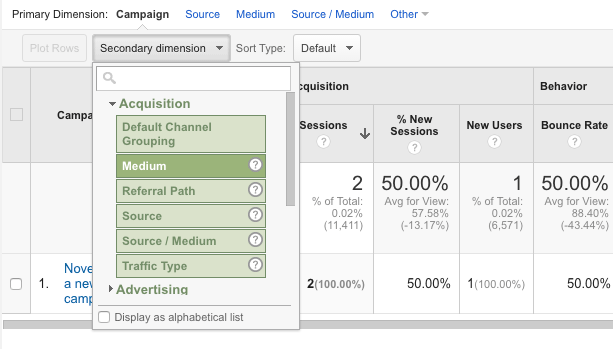Demystifying the 'Secondary Dimension' in Google Analytics: Key Insights
Demystifying the 'Secondary Dimension' in Google Analytics: Key Insights
Blog Article
Deciphering the Relevance of Secondary Measurement in Google Analytics: Everything About Its Importance and Influence
In the world of digital analytics, the usage of second measurements within Google Analytics acts as an essential device for discerning deeper layers of data insights. The relevance of secondary measurements depends on their capacity to supply a nuanced sight of individual behavior and interaction with a site or platform. By exploring information beyond surface-level metrics, companies can unlock a wide range of info that forms critical decisions and fine-tunes marketing efforts. This exploration right into the realm of additional dimensions not just provides a thorough understanding of individual involvement yet additionally loses light on the detailed characteristics that drive on the internet efficiency.
Understanding Second Measurements in Google Analytics
The understanding of second measurements in Google Analytics is necessary for acquiring much deeper insights into customer behavior and site performance. While primary dimensions offer basic data factors such as web traffic resources and web page sights, second measurements allow for an extra nuanced analysis by supplying added context to these main metrics. By integrating second measurements, individuals can section and filter their information to reveal patterns and trends that may not be immediately apparent.

Revealing the Conveniences of Second Measurements
Building upon the fundamental understanding of additional dimensions in Google Analytics, exploring the advantages they offer reveals very useful understandings for enhancing information analysis and decision-making. By incorporating second dimensions, users can dive much deeper into their data, gaining a much more comprehensive sight of individual actions, material efficiency, and other vital metrics.
In addition, additional measurements supply context to main data, offering additional layers of information that can aid in recognizing individual interactions and preferences. This improved understanding can lead strategic decision-making, causing more targeted marketing projects, website optimizations, and overall improved efficiency. Essentially, additional dimensions serve as a powerful tool for opening deeper understandings and optimizing the energy of Google Analytics for companies and site proprietors.
Leveraging Second Measurements for Enhanced Insights
By harnessing the power of second dimensions in Google Analytics, businesses can reveal deeper understandings that drive educated decision-making and tactical optimization initiatives. Leveraging additional dimensions permits services to dive beyond surface-level data and acquire a much more thorough understanding of user habits, target market demographics, traffic sources, and website efficiency. As an example, by integrating main dimensions like web traffic sources with second measurements such as geographic location or tool classification, companies can identify which regions or gadgets are driving the most valuable web traffic to their internet site.
Furthermore, second dimensions allow companies to segment and assess data much more properly, aiding them recognize trends, patterns, and possibilities that may have otherwise gone undetected. By utilizing additional dimensions, companies can customize their advertising and marketing approaches, material, and customer experience to better meet the needs and preferences of their target audience. Basically, leveraging second dimensions in Google Analytics equips organizations to make data-driven decisions that cause improved performance, enhanced ROI, and sustainable growth.
Effect of Second Dimensions on Data Evaluation
Enhancing information analysis through the use of secondary dimensions in Google Analytics provides companies with a much deeper understanding of their online performance metrics. By integrating second measurements, such as time of day, geographic location, or tool classification, businesses can discover useful insights that might have been ignored with primary measurements alone. This improved degree of granularity enables for more specific division of information, enabling organizations to determine patterns, patterns, and relationships that can drive critical decision-making.
Maximizing Possible: Additional Dimensions Techniques
One key technique is to combine secondary dimensions with main measurements to gain an extensive sight of individual interactions. Combining the main dimension of 'source/medium' with secondary measurements like 'touchdown page' or 'device classification' can disclose which channels are driving traffic to details pages or just how individual actions varies throughout gadgets.
Additionally, using second measurements to sector information based on individual demographics, behavior, or technology can help services customize their marketing efforts to particular audience sections. This targeted strategy can cause boosted conversion prices, boosted customer experiences, and ultimately, Look At This enhanced ROI. By making the most of the potential of additional measurements in Google Analytics, companies can make educated decisions, maximize their on-line presence, and drive lasting development.
Conclusion
In conclusion, second measurements in Google Analytics play a critical role in giving much deeper understandings and improving data evaluation. By using secondary dimensions effectively, see this page services can acquire an extra extensive understanding of individual actions and website efficiency. Including additional dimensions into data evaluation approaches can cause even more informed decision-making and boosted general efficiency. It is essential for companies to take advantage of the power of additional dimensions to maximize their potential and attain greater success in their online endeavors (what is a “secondary dimension” in google analytics?).
While main measurements supply essential data points such as traffic resources and page views, secondary measurements enable for a much more nuanced evaluation by supplying added context to these main metrics. By incorporating main dimensions like website traffic resources with secondary dimensions such as geographical area or gadget group, companies can determine which regions or gadgets are driving the most beneficial website traffic to their internet site.
By integrating secondary dimensions, such as time of day, geographical area, or gadget group, companies can discover beneficial understandings that might have been overlooked with primary measurements alone. One key technique is to integrate additional measurements with primary measurements to obtain an extensive sight of customer interactions. Combining the key dimension of 'source/medium' with additional measurements like 'touchdown web page' or 'gadget classification' can expose which networks are driving website traffic to certain web pages or how customer habits differs Look At This across tools.
Report this page